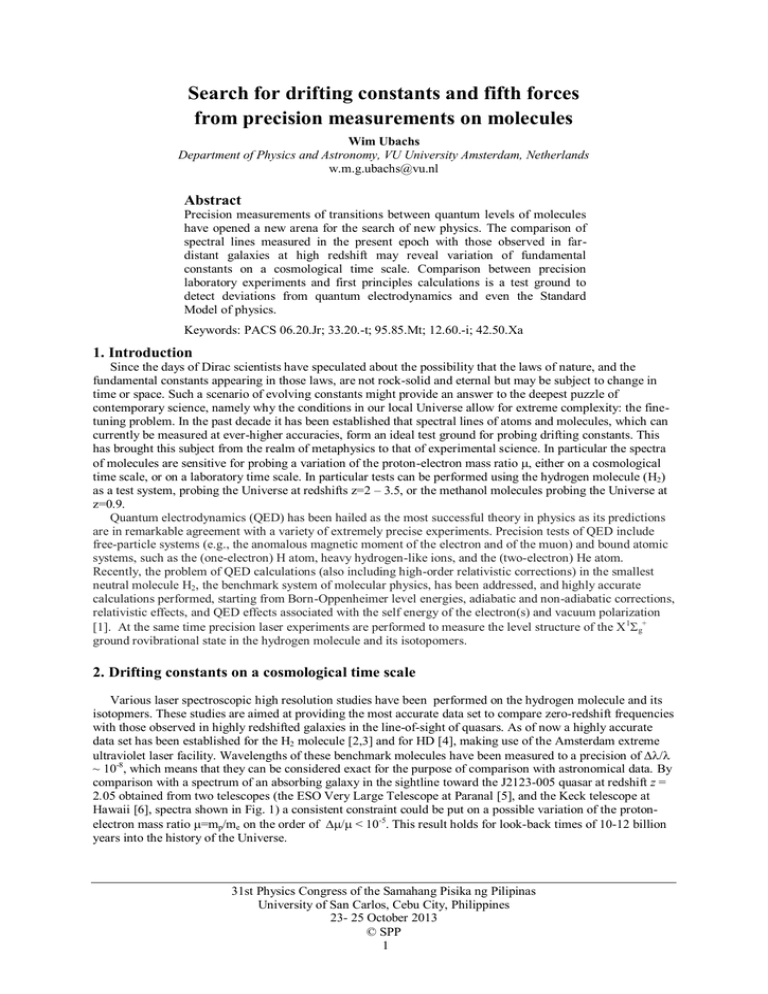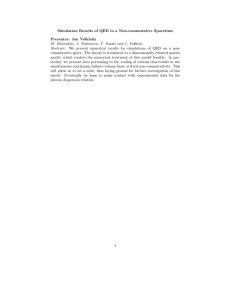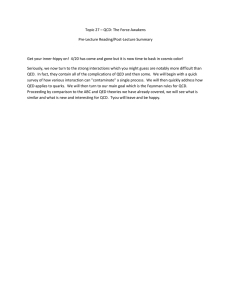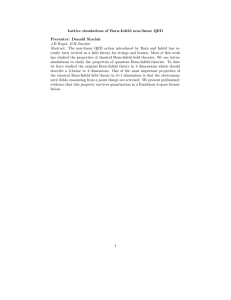Search for drifting constants and fifth forces Abstract
advertisement

Search for drifting constants and fifth forces from precision measurements on molecules Wim Ubachs Department of Physics and Astronomy, VU University Amsterdam, Netherlands w.m.g.ubachs@vu.nl Abstract Precision measurements of transitions between quantum levels of molecules have opened a new arena for the search of new physics. The comparison of spectral lines measured in the present epoch with those observed in fardistant galaxies at high redshift may reveal variation of fundamental constants on a cosmological time scale. Comparison between precision laboratory experiments and first principles calculations is a test ground to detect deviations from quantum electrodynamics and even the Standard Model of physics. Keywords: PACS 06.20.Jr; 33.20.-t; 95.85.Mt; 12.60.-i; 42.50.Xa 1. Introduction Since the days of Dirac scientists have speculated about the possibility that the laws of nature, and the fundamental constants appearing in those laws, are not rock-solid and eternal but may be subject to change in time or space. Such a scenario of evolving constants might provide an answer to the deepest puzzle of contemporary science, namely why the conditions in our local Universe allow for extreme complexity: the finetuning problem. In the past decade it has been established that spectral lines of atoms and molecules, which can currently be measured at ever-higher accuracies, form an ideal test ground for probing drifting constants. This has brought this subject from the realm of metaphysics to that of experimental science. In particular the spectra of molecules are sensitive for probing a variation of the proton-electron mass ratio , either on a cosmological time scale, or on a laboratory time scale. In particular tests can be performed using the hydrogen molecule (H2) as a test system, probing the Universe at redshifts z=2 – 3.5, or the methanol molecules probing the Universe at z=0.9. Quantum electrodynamics (QED) has been hailed as the most successful theory in physics as its predictions are in remarkable agreement with a variety of extremely precise experiments. Precision tests of QED include free-particle systems (e.g., the anomalous magnetic moment of the electron and of the muon) and bound atomic systems, such as the (one-electron) H atom, heavy hydrogen-like ions, and the (two-electron) He atom. Recently, the problem of QED calculations (also including high-order relativistic corrections) in the smallest neutral molecule H2, the benchmark system of molecular physics, has been addressed, and highly accurate calculations performed, starting from Born-Oppenheimer level energies, adiabatic and non-adiabatic corrections, relativistic effects, and QED effects associated with the self energy of the electron(s) and vacuum polarization [1]. At the same time precision laser experiments are performed to measure the level structure of the X 1g+ ground rovibrational state in the hydrogen molecule and its isotopomers. 2. Drifting constants on a cosmological time scale Various laser spectroscopic high resolution studies have been performed on the hydrogen molecule and its isotopmers. These studies are aimed at providing the most accurate data set to compare zero-redshift frequencies with those observed in highly redshifted galaxies in the line-of-sight of quasars. As of now a highly accurate data set has been established for the H2 molecule [2,3] and for HD [4], making use of the Amsterdam extreme ultraviolet laser facility. Wavelengths of these benchmark molecules have been measured to a precision of ~ 10-8, which means that they can be considered exact for the purpose of comparison with astronomical data. By comparison with a spectrum of an absorbing galaxy in the sightline toward the J2123-005 quasar at redshift z = 2.05 obtained from two telescopes (the ESO Very Large Telescope at Paranal [5], and the Keck telescope at Hawaii [6], spectra shown in Fig. 1) a consistent constraint could be put on a possible variation of the protonelectron mass ratio =mp/me on the order of < 10-5. This result holds for look-back times of 10-12 billion years into the history of the Universe. 31st Physics Congress of the Samahang Pisika ng Pilipinas University of San Carlos, Cebu City, Philippines 23- 25 October 2013 © SPP 1 Figure 1. Comparison between the spectrum of the J2123-005 quasar system in the 3097 – 3106 Å range observed with HIRES-Keck (upper panel) and UVES-VLT (lower panel) telescopes. The hydrogen molecule, although observable very deep into the Universe, is not very sensitive to a possible variation of the fundamental constant . It has been shown that certain transitions in polyatomic molecules are much more sensitive, in particular some microwave transitions in the methanol (CH3OH) molecule [7]. These specific transitions in methanol were recently observed with the 100m single-dish radio telescope at Effelsberg in Germany in an extragalactic object at a redshift z=0.89. From a detailed analysis on sensitivities of the lines and the frequencies detected a constraint could be established of < 10-7. This result holds for look-back times of 7 billion years [8]. These observations set a limit on a possible variation of a fundamental constant in the early Universe. Work is in progress to constrain these bounds further. It should be noted that the Standard Model of physics does not have an explanation for the values of the coupling constants, so the most fundamental theory does not exclude possible drifts in the values of the fundamental constants. 3. Tests of QED in molecular hydrogen and the search for a fifth force Experimentally the ionization limit of the hydrogen isotopomers was determined in a combination of three experiments: (1) the energy separation between X1g+, v=0, J=1 and EF1g+, v=0, J=1 was determined via Doppler-free two-photon excitation using a narrowband pulsed UV-laser, where the calibration was performed by a frequency comb laser; (2) the separation between EF1g+, v=0, J=1 and 54p11(0) measured in one photon UV spectroscopy; (3) the extrapolation of millimeter wave spectroscopy on the Rydberg series to determine the ionization limit. The values for the ionization potential were converted into a value for the dissociation limit including information of the H2+ ion and the H-atom, accurately known from experiment and theory [9]. In Table 1 results are given for H2, HD and D2, with a comparison to the theoretical calculations. This constitutes a sensitive test of QED effects, since the QED contribution to the binding energies is 0.1964(9) cm -1 (for the case of H2). Table 1: Experimental and theoretical values for the dissociation limits of the hydrogen isotopomers. All values in cm-1. ____________________________________________________________ Experiment Theory [1] ____________________________________________________________ Ediss(H2) 36118.0696(4) [9] 36118.0695(10) Ediss(HD) 36405.7837(4) [10] 36405.7828(10) Ediss(D2) 36748.3629(7) [11] 36748.3633(9) ____________________________________________________________ In an independent experiment Doppler-free two-photon laser excitation in the EF1g+ - X1g+ system was performed for a progression of rotational states in H2. High rotational quantum states up to J=16 were prepared by a photochemical process involving photolysis of HBr molecules, and a subsequent reaction H + HBr Br + H2(J). The information from the accurately calibrated lines was transferred to binding energies of the H2, v=0, J 31st Physics Congress of the Samahang Pisika ng Pilipinas University of San Carlos, Cebu City, Philippines 23- 25 October 2013 © SPP 2 states; from the resulting values the (theoretical) non-QED values were subtracted in order to make a comparison of QED-effects (including high-order relativistic effects) in the rotational sequence in H2. The comparison is shown in Fig. 2. Excellent agreement is obtained for the calculation of QED effects in the rotational sequence [12]. Figure 2: Rotational level energies of H2, v=0, J states (triangles and righthand scale). Experimentally determined (black symbols) and theoretically calculated values for the QED and high-order relativistic effects (lefthand scale, corrected for the shift of the J=0 level: 0.7283 cm-1). In a further experiment Doppler-free two-photon laser excitation is performed on the EF1g+ - X1g+ (0,1) band. Hydrogen molecules are vibrationally excited in a discharge before entering a molecular beam. The result result is shown in Fig. 3, displaying a spectrum of the Q(0) two-photon line in the (0,1) band. These measurements provide accurate values for the vibrational ground tone splitting in hydrogen and its isotopomers, which are confronted with QED calculations and found to be in agreement [13]. Figure 3: Recording of the Q(0) two-photon line in the EF-X (0,1) band. The results obtained on the precision measurements on the hydrogen molecule are found in full agreement with QED. This means that they are consistent with the laws of quantum mechanics invoking a single force, that of electromagnetism. Since the other known forces, the strong force, the weak force, and gravity have no influence on the level structure of the light H2 molecule a test of QED in fact implies a test of the Standard Model of Physics. Bounds on deviations from known forces, or bounds on novel fifth forces can be derived from these studies [14]. When a fifth force is represented by a Yukawa-type potential: e r / V5 (r ) 5 r with 5 the coupling strength and the range of the force the studies on molecular hydrogen yield a bound on the coupling strengths of 5/EM < 10-9, where EM is the coupling strength of electromagnetism, or the fine structure constant. 31st Physics Congress of the Samahang Pisika ng Pilipinas University of San Carlos, Cebu City, Philippines 23- 25 October 2013 © SPP 3 Acknowledgements The author acknowledges the collaboration of Julija Bagdonaite, Hendrick Bethlem, Gareth Dickenson, Kjeld Eikema, Paul Jansen, Jeroen Koelemeij, Michael Murphy, Krzystof Pachucki and Edcel Salumbides and support from FOM. References 1. 2. 3. 4. 5. 6. 7. 8. 9. 10. 11. 12. 13. 14. J. Komasa, K. Piszczatowski, G. Lach, M. Przybytek, B. Jeziorski, and K. Pachucki, “Quantum electrodynamic effects in rovibrational spectra of molecular hydrogen,” J. Chem. Theory Comp. 7, 310531155 (2011). W. Ubachs, E. Reinhold, “Highly accurate H2 Lyman and Werner band laboratory measurements and an improved constraint on a cosmological variation of the proton-to-electron mass-ratio”, Phys. Rev. Lett. 92, 101302 (2004). E. Reinhold, R. Buning, U. Hollenstein, A. Ivanchik, P. Petitjean, W. Ubachs, “Indication of a cosmological variation of the proton-electron mass ratio based on laboratory measurement and reanalysis of H2 spectra”, Phys. Rev. Lett. 96, 151101 (2006). T.I. Ivanov, M. Roudjane, M.O. Vieitez, C.A. de Lange, W.U.L. Tchang-Brillet, W. Ubachs, “On a variation of the proton-electron mass ratio HD as a probe for detecting mass variation on a cosmological time scale”, Phys. Rev. Lett. 100, 093007 (2008). F. van Weerdenburg, M.T. Murphy, A.L. Malec, L. Kaper, W. Ubachs, “First constraint on cosmological variation of the proton-to-electron mass ratio from two independent telescopes”, Phys. Rev. Lett. 106, 180802 (2011). A.L. Malec, R. Buning, M.T. Murphy, N. Milutinovic, S.L. Ellison, J.X. Prochaska, L. Kaper, J. Tumlinson, R.F. Carswell, W. Ubachs, “Keck telescope constraint on cosmological variation of the protonto-electron mass ratio”, Monthly Not. Royal Astron. Society 403, 1541 (2010). P. Jansen, L.-H. Xu, I. Kleiner, W. Ubachs, H.L. Bethlem, “Methanol as a sensitive probe for spatial and temporal variations of the proton-to-electron mass ratio”, Phys. Rev. Lett. 106, 100801 (2011). J. Bagdonaite, P. Jansen, C. Henkel, H.L. Bethlem, K.M. Menten, W. Ubachs, “A stringent limit on a drifting proton-to-electron mass ratio from alcohol in the early Universe”, Science 339, 46 (2013). J. Liu, E.J. Salumbides, U. Hollenstein, J.C.J. Koelemeij, K.S.E. Eikema, W. Ubachs, and F. Merkt, “Determination of the ionization and dissociation energies of the hydrogen molecule”, J. Chem. Phys. 130, 174306 (2009). D. Sprecher, J. Liu, W. Ubachs, Ch. Jungen, and F. Merkt, “Determination of the ionization and dissociation energies of HD”, J. Chem. Phys. 133, 111102 (2010). J. Liu, D. Sprecher, Ch. Jungen, W. Ubachs, and F. Merkt, “Determination of the ionization and dissociation energies of D2”, J. Chem. Phys. 132, 154301 (2010). E.J. Salumbides, G.D. Dickenson, T.I. Ivanov and W. Ubachs, “QED effects in molecules; test on rotational quantum states of H2”, Phys. Rev. Lett. 107, 043005 (2011). G.D. Dickenson, M.L. Niu, E.J. Salumbides, J. Komasa, K.S.E. Eikema, K. Pachucki, W. Ubachs, “Fundamental Vibration of Molecular Hydrogen”, Phys. Rev. Lett. 110, 193601 (2013) E.J. Salumbides, J.C.J. Koelemeij, J. Komasa, K. Pachucki, K.S.E. Eikema, W. Ubachs, “Bounds on fifth forces from precision measurements on molecules”, Phys. Rev. D87, 112008 (2013). 31st Physics Congress of the Samahang Pisika ng Pilipinas University of San Carlos, Cebu City, Philippines 23- 25 October 2013 © SPP 4




